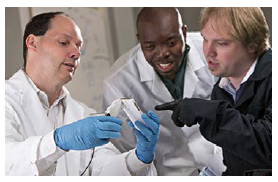Pressure Sensitive Gloves Designed To Detect Tumors
Trending now: From gloves with built-in sensors to dissolving brain implants, technology is changing how health information is collected.
 Healthcare practitioners may one day be able to physically screen for breast cancer using pressure-sensitive rubber gloves to detect tumors, owing to a transparent, bendable, and sensitive pressure sensor newly developed by Japanese and American teams.
Healthcare practitioners may one day be able to physically screen for breast cancer using pressure-sensitive rubber gloves to detect tumors, owing to a transparent, bendable, and sensitive pressure sensor newly developed by Japanese and American teams.
Conventional pressure sensors are flexible enough to fit to soft surfaces such as human skin, but they cannot measure pressure changes accurately once they are twisted or wrinkled, making them unsuitable for use on complex and moving surfaces. To address this, an international team of researchers led by Dr. Sungwon Lee and Professor Takao Someya of the University of Tokyo’s Graduate School of Engineering have developed a nanofiber-type pressure sensor that can measure pressure distribution of rounded surfaces such as an inflated balloon and maintain its sensing accuracy even when bent over a radius of 80 micrometers, equivalent to just twice the width of a human hair. The sensor is roughly 8 micrometers thick and can measure the pressure in 144 locations at once.
Technology Transforms Cell Phone Into High-Powered Microscope
New technology that transforms a cell phone into a powerful, mobile microscope could significantly improve malaria diagnoses and treatment in developing countries that often lack the resources to address the life-threatening disease, says a Texas A&M University biomedical engineer who has created the tool.
 The add-on device, which is similar in look and feel to a protective phone case, makes use of a smartphone’s camera features to produce high-resolution images of objects 10 times smaller than the thickness of a human hair, says Gerard Coté, professor of biomedical engineering and director of the Texas A&M Engineering Experiment Station’s Center for Remote Health Technologies and Systems. Professor Coté’s development of the instrument, known as a mobile-optical-polarization imaging device (MOPID), is detailed in the online scientific journal Scientific Reports, published by Nature.
The add-on device, which is similar in look and feel to a protective phone case, makes use of a smartphone’s camera features to produce high-resolution images of objects 10 times smaller than the thickness of a human hair, says Gerard Coté, professor of biomedical engineering and director of the Texas A&M Engineering Experiment Station’s Center for Remote Health Technologies and Systems. Professor Coté’s development of the instrument, known as a mobile-optical-polarization imaging device (MOPID), is detailed in the online scientific journal Scientific Reports, published by Nature.
Tiny Electronic Implants Monitor Brain Injury, Then Melt Away
A new class of small, thin electronic sensors can monitor temperature and pressure within the skull — crucial health parameters after a brain injury or surgery — then melt away when they are no longer needed, eliminating the need for additional surgery to remove the monitors and reducing the risk of infection and hemorrhage.
Similar sensors can be adapted for postoperative monitoring in other body systems as well, researchers say. The project led by John A. Rogers, Ph.D., a professor of materials science and engineering at the University of Illinois at Urbana-Champaign, and Wilson Ray, a professor of neurological surgery at the Washington University School of Medicine in St. Louis, published their work in the journal Nature.
“This is a new class of electronic biomedical implants," says Dr. Rogers, who directs the Frederick Seitz Materials Research Laboratory at Illinois. “These kinds of systems have potential across a range of clinical practices, where therapeutic or monitoring devices are implanted or ingested, perform a sophisticated function, and then resorb harmlessly into the body after their function is no longer necessary."
Cedars-Sinai To Use Fitbits in Small Trial of Cancer Patients
Cedars-Sinai Medical Center is embarking on a 30-patient study to see if a Fitbit Charge HR can help oncologists assess whether their patients are active enough for chemotherapy, reports MobiHealthNews. Doctors at Cedars-Sinai Samuel Oschin Comprehensive Cancer Institute say patients who are spending more time in bed usually get harmed by chemotherapy, even if the cancer is responsive to the treatment, and the more active the patient is the better the outcome.
The current process for evaluating how much patients are moving are self-reported patient assessments, and those accounts are not always accurate.
In addition, researchers want to determine whether the combination of the Fitbit and patient-reported-outcome questionnaires can help physicians screen patients for factors such as fatigue, distress, pain, and trouble sleeping, which patients can underreport. (PV)










